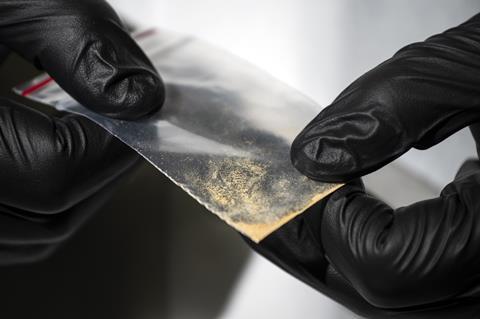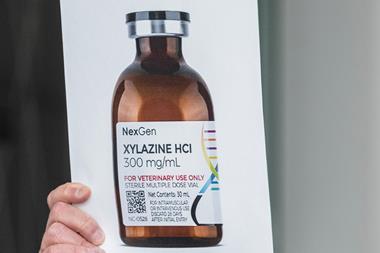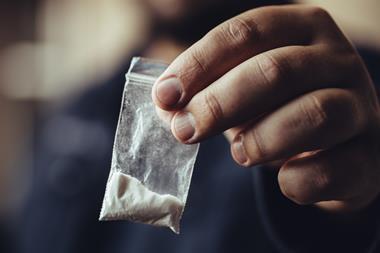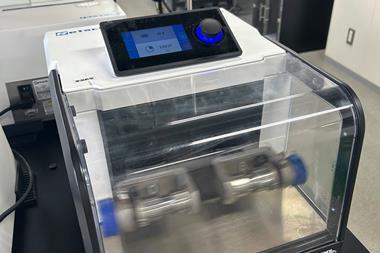Historically, most of the heroin in the UK came from Afghanistan. However, in 2022, the Taliban banned poppy cultivation and after December 2023 it became illegal to export heroin from Afghanistan.
At the same time, an increasing quantity of synthetic drugs such as nitazenes and xylazine have been detected in the illicit drug market both internationally and in the UK and it is feared that a recent spike in related deaths could indicate a much larger problem than estimates currently suggest.

‘These synthetics are quite cheap, and they’re very strong, which means that you only have to ship a small amount that you can then dilute at destination to make up a lot of doses,’ explains Caroline Copeland, an expert in pharmacology and toxicology and director of the National Programme on Substance Abuse Deaths at King’s College London.
But what exactly are these compounds, where have they come from and how do they cause harm?
What are these synthetic drugs?
Xylazine – also known as ‘tranq’ – is a non-opioid tranquiliser approved for use as a sedative, muscle relaxant and analgesic in veterinary medicine.
It is an α-2 adrenoceptor agonist – part of the G protein-coupled receptor family – that works in a similar way to opioids but binds the α-2 receptor rather than the μ-opioid receptor. Xylazine decreases the release of noradrenaline in the peripheral and central nervous systems, leading to a reduced heart rate and a drop in blood pressure.
There are two other α-2-adrenoceptor agonists – detomidine and medetomidine – but these are not as widely misused.
In contrast, 2-benzyl benzimidazole opioids – or nitazenes – are a class of synthetic opioid developed in the 1950s as an alternative opioid for pain relief. However, they were found to be so potent that they were never approved for human or veterinary use.
Nitazenes are structurally unrelated to other opioid drug groups, including morphine and fentanyl, however they still bind the μ-opioid receptor, resulting in euphoria, relaxation, pain relief and drowsiness. There are around 15 different nitazenes with varying potencies, but some are much more potent than morphine or heroin.
‘The stronger [nitazenes] are between 10 to 16 times more potent than fentanyl and those are the ones we’ve seen the most deaths from,’ explains Copeland.
Where have these drugs come from?
Xylazine could have been diverted from the veterinary drug market to the illicit one. But Copeland says that ‘we cannot find any evidence for within country diversion from veterinary supplies [in the UK]’.
‘We think it’s just coming along the route of the other illicit substances like the nitazenes, being synthesised specifically for illicit use,’ she adds.
According to the Advisory Council on the Misuse of Drugs (ACMD), nitazenes can be prepared in a few steps from legal, readily available precursors. There is limited information on the manufacture, trafficking, distribution and use of nitazenes but it has been reported that some of the isotonitazene sold in Europe was manufactured by chemical companies based in China and several nitazenes are sold on the dark net.
How did we become aware of the problem in the UK?
Xylazine in combination with fentanyl was declared an emerging threat by the White House in April 2023. ‘In the US deaths due to xylazine in 2018, were about 250. And by 2021, that was over 3500,’ says Copeland.
The first UK death related to xylazine was reported by the National Programme on Substance Abuse Deaths in December 2022. The post-mortem implicated xylazine, alongside heroin, fentanyl and cocaine, in the death. Following this death, Copeland and colleagues contacted all NHS and commercial post-mortem toxicology laboratories in the UK up to August 2023 and collated evidence that showed that xylazine had been found in 16 people, 11 of whom died.
However, these deaths are likely to be ‘a gross underestimate’ of use of these drugs in the UK. This is in part because of the lack of any in-person drug-checking facilities and because police and medical examination labs do not routinely test for them.
‘The only lab that was testing for xylazine pre-May 2022 was a lab in Birmingham,’ explains Copeland. ‘He’d only added it to his screen because he’d seen reports of what was happening in the US – all the other labs only added it to their screens after May 2023.’
Meanwhile, the UK National Crime Agency has reported 100 nitazene-related deaths since summer 2023 with further cases awaiting testing.
How is it being taken?
Xylazine has been reported as an adulterant in an increasing number of illicit drug mixtures – it is commonly encountered in combination with fentanyl.
‘The problem with fentanyl is that by design for its clinical use, it’s quite short acting – about half an hour – whereas heroin is anything between four to six hours, and so to try and recreate the heroin high, xylazine is being added in to try and get this elongated effect,’ explains Copeland.
Xylazine has also been detected in mixtures containing cocaine or heroin, as well as on its own, though this is less frequently reported. In Copeland’s study they also discovered xylazine in tablets such as codeine, diazepam and tramadol, as well as in illicit THC vape fluid which she describes as ‘concerning’.
Nitazenes have been sold as powders or nasal sprays and are administered by intravenous, sublingual or nasal routes or by vaping. They may also be added to heroin, or as constituents of counterfeit medicines.
However, Copeland says that with both drugs, in a lot of cases, ‘people don’t realise they’re taking it – they think they’re taking something else’.
How dangerous are they?
The harms of xylazine are both acute and chronic. ‘[Xylazine] causes sedation, so if you mix it with other sedatives like opioids, that’s a risk for overdose, and people stopping breathing,’ explains Copeland.
‘But it also causes constriction of blood vessels and if you don’t have delivery of blood tissues, you don’t have oxygen or nutrient delivery and you don’t have removal of waste products, and that can lead to the tissue dying. The areas of the body that are most susceptible to that are the extremities … and these open wounds can form and if they get infected, there are reports in the US of amputations having to be done as a result.’
With nitazenes, like other opioids, they can cause fatal respiratory depression. However, due to their potency, relatively low doses are needed to achieve the desired effects and the risk of accidental overdose is much higher than morphine or heroin.
‘You need the amount of a grain of sand or even smaller, to prove fatal,’ explains Copeland. ‘Xylazine is not as toxic on its own, but if you start mixing multiple sedatives together, it’s going to increase risk of death.’
Is there an antidote to either of these drugs?
Nitazene overdose can be treated effectively with the opioid antagonist naloxone although more may be needed than with heroin or fentanyl overdoses.
For xylazine, several existing α-2 adrenoceptor antagonists could potentially reverse toxicity. These include yohimbine, an indole alkaloid, and atipamezole, a veterinary drug, but neither have been fully tested in humans.
How are these drugs regulated?
As of March 2024, all nitazenes are now banned as Class A drugs under the Misuse of Drugs Act 1971, with tougher measures for anyone caught supplying them, including up to life imprisonment, an unlimited fine or both. In addition, the government said laws would be ‘future proofed’ by introducing a generic definition of nitazenes, to capture any new drugs that emerge.
Xylazine is not currently controlled under the Misuse of Drugs Act 1971 but is likely subject to the 2016 Psychoactive Substances Act because of its psychoactive effects.
However, at the end of February 2024, the ACMD recommended xylazine be made Class C because of the recent increase in the number of detections in the UK, the likelihood of further increases in its prevalence and the potential health and social harms. In March 2024, the government said it had accepted the recommendation and intended to introduce legislation.
Copeland says that to combat demand for these drugs ‘requires investment into the social care and support of a very deprived demographic of people who haven’t exactly ingratiated themselves with society’.
Harm reduction services, such as test strips, could help identify the presence of these substances but results can take up to a week to come. ‘There’s a real need for rapid turnaround time checking,’ says Copeland. ‘People need to be aware of what they’re taking.’



















No comments yet